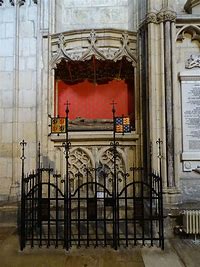The seeds of the Wars of the Roses were set!
|
William was born in the February of 1337 at Hatfield in Yorkshire, he was the second son of Edward III and Philippa of Hainault, however the boy would only live for five months, he died on the 8th July and his body would be laid to rest in York Minster. A golden statue or weeper of William can be seen on the tomb of his father Edward III in Westminster Abbey. William's older brother Edward the Black Prince had predeceased his father, the death of both these men would leave the country in the hands of various family members notably Richard II - child monarch, John of Gaunt - an ambitious and lustful protector and Henry of Bolingbroke - a murderous would-be monarch.
The seeds of the Wars of the Roses were set!
0 Comments
On the 22nd November in 1392 Robert de Vere, 9th Earl of Oxford, a favourite of Richard II, died near Louvain in Belgium. He had received the Earldom of Oxford when he was nine years old, was knighted along with the king, Richard's uncle Thomas of Woodstock and Henry of Bolingbroke, the future Henry IV. Robert de Vere benefited greatly from his friendship with the king, he was given his own rooms in Richard's castles, granted estates, gifts and other nobles' inheritances. He was also given the title Marquess of Dublin, yet he never set foot in Ireland. However, he is mostly remembered for his opposition to the Lords Appellant, a group of nobles who sort to bring the king to task over his reliance on his favourites, at Radcote Bridge.
Robert de Veres forces were soon surrounded and after a short clash of weapons, de Vere was quick to realise the danger of his position and abandoned his men, leaving many of them to the mercy of their enemy and made his cowardly escape by crossing the river, supposedly in disguise, and headed to the Netherlands. A year later, in what has come to be known as the Merciless Parliament he was found guilty of treason and a death sentence was passed in his absence. Robert de Vere spent the rest of his life in exile, thus avoiding the executioner's blade. His death left Richard II bereft. Three years later, on the anniversary of his death, the king had de Vere's embalmed body brought back to England for burial in the Priory at Earl's Colne, in Essex. Henry Percy, first Earl of Northumberland was, according to Shakespeare: "the ladder upon which the mounting Bolingbroke ascends the throne.” This statement reflects the rise of the Percy family during the reign of Richard II and the subsequent usurpation of the throne by Henry Bolingbroke. Henry Percy was born on the 10th November 1341/2. The first two decades of Percy's life were unremarkable, however the twenty years following his father's death lead Percy to great heights of power and influence, not only in his own stamping ground but in the country as a whole. Henry Percy headed a family that included his sons Henry 'Hotspur' and Thomas, all three were guardians of the English boarder with Scotland. As Lords of the North, and as the previous statement states, they were involved in the future Henry IV taking the crown of England. However, siding with Henry had its problems, and the Percy's would soon regret helping Bolingbroke take his seat on the throne of England. We cannot think of the Percy family without considering the part they played in the Wars of the Roses. Many believe that the First Battle of St Albans, in 1455, was as much about the ongoing squabble between the Percy's and their nemesis the Neville's, as it was about the wider squabble, that of the House of York and Lancaster. It cannot be doubted that this battle, for the individual members of these two northern families, was very personal, each trying to destroy the other under the guise of a greater cause. The origins of Percy/Neville squabble had it roots in land, or the loss of it, bitterness turned to anger, discussion to litigation, skirmishes into outright warfare that initiated the 'the beginning of the greatest sorrows in England." Henry Percy died a traitor at Bramham Moor, the last battle of the Percy's rebellion, on the 19 February 1408 and as was the norm for a traitor, his head was decapitated and sent to London, placed for all to see on London Bridge, it was reunited with his quartered remains and eventually buried in York Minster.
|
Categories
All
Archives
May 2024
|






 RSS Feed
RSS Feed
